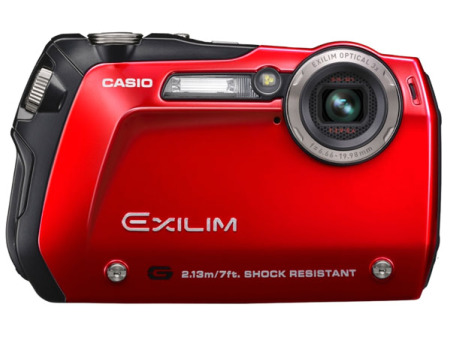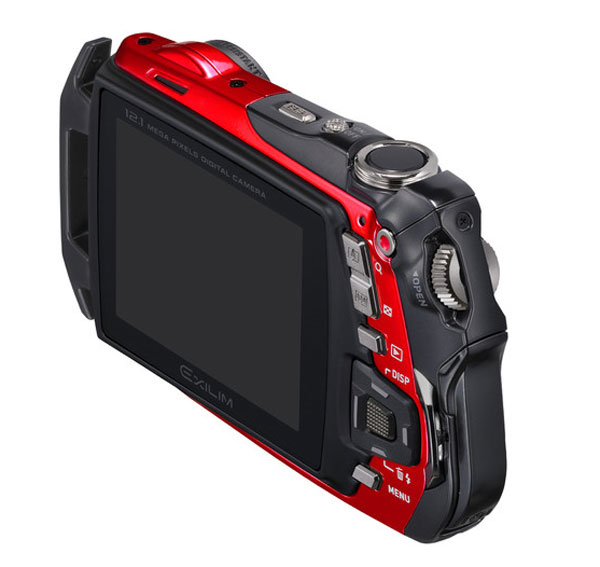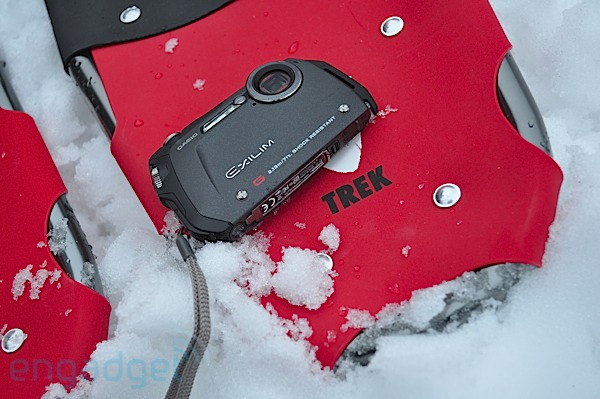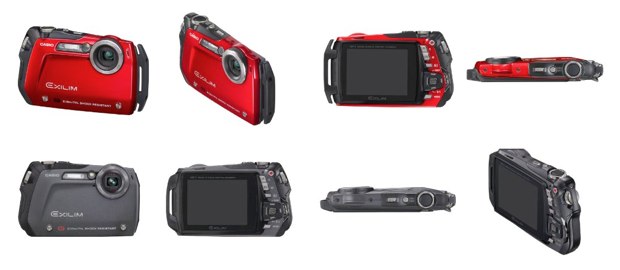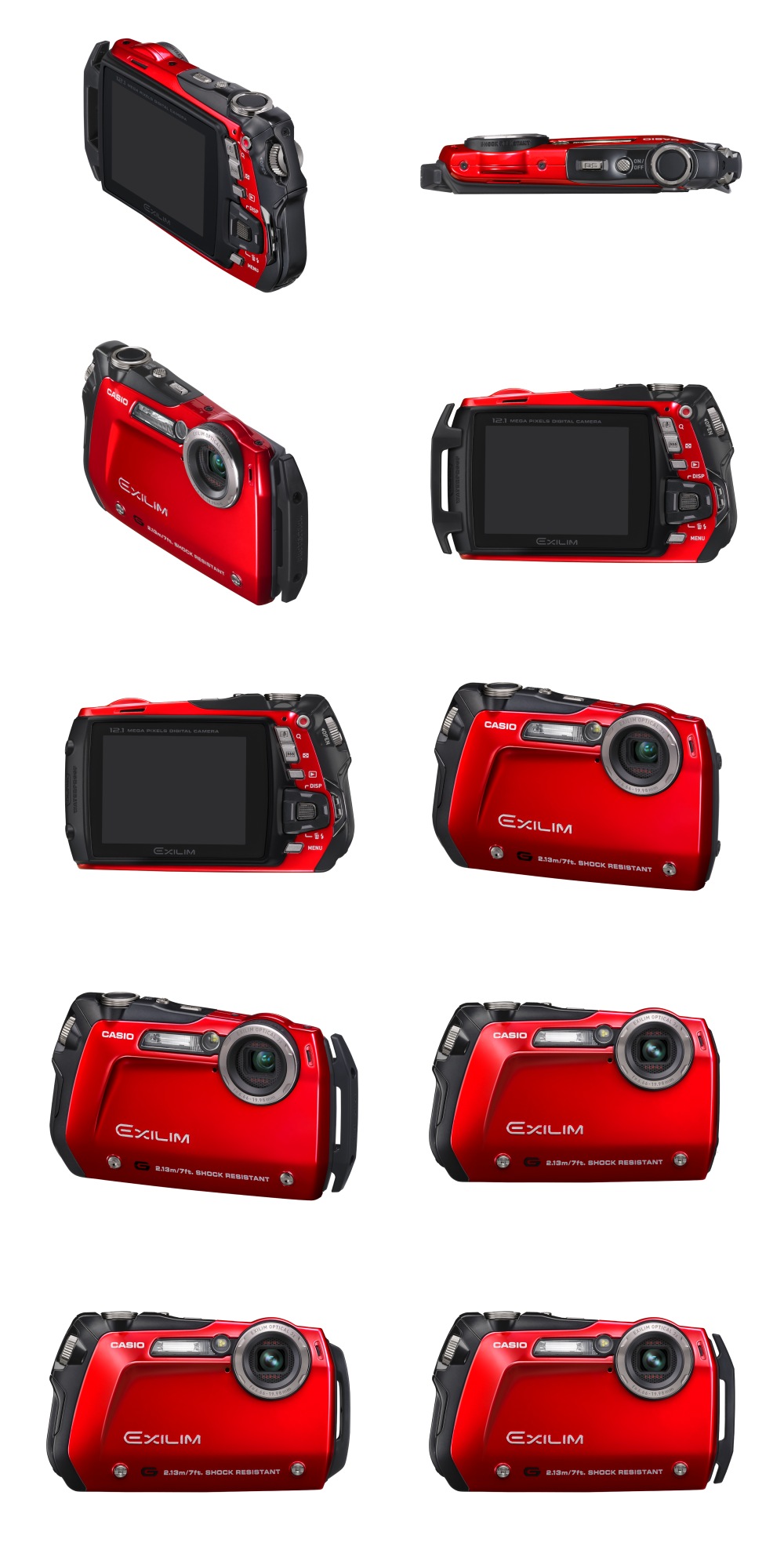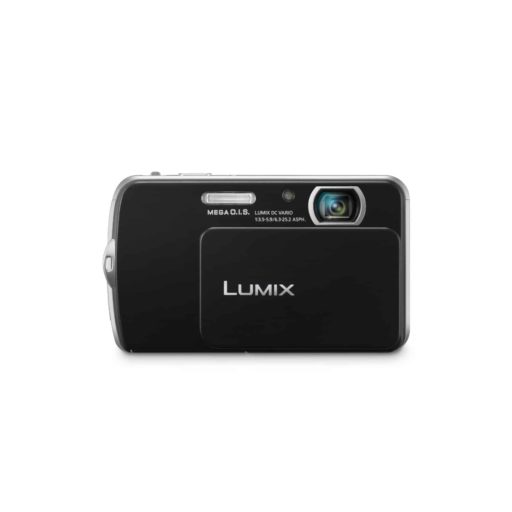The Casio Exilim EX-G1 is the first compact camera which is rated the G-series. G-series manufacturer designed it to be able to withstand bumps, shock and knocks…
They’ve been making durable watches for years, but the Exilim G1 is Casio’s first foray into the rugged camera category. I like to call this class of snapshooters the tough guys of photography. They’re designed to withstand drops and underwater submersions of a few feet―nothing too extreme, but sturdy enough to take on some outdoor excursions to the beach or up a ski mountain without worrying about breaking the thing.
The $229.99 (list) 12.1-megapixel Casio Exilim G EX-G1 is surprisingly slim and attractive for a ruggedized camera that can shoot underwater and survive drops up to 7 feet. With a hotrod red paint job and lines worthy of a stealth fighter plane, this sub-1-inch-thick camera is rugged enough to operate at depths of 10 feet of water. The G1 is much thinner than its rugged competitors, but its images don’t measure up.
The 5.1-ounce G1’s appearance is definitely one of its strongest features. The camera’s two color options–red and dark grey—are both very glossy and remind me of the Marvel comic book superheroes Iron Man and War Machine. The 2.5-inch 230K-dot LCD screen, framed by black rubber, is on the small side, but considering the G1’s compact 2.5-by-4-by-0.78-inch (HWD) housing, it doesn’t appear out of proportion.
Unfortunately, picture quality has always been an issue with this type of camera. Even the best of the bunch thus far (last year, our favorite was the Olympus TOUGH 8000) took shots with a slightly grainy, flat quality to them―passable, but with plenty of room for improvement. We’re happy to report that Casio stepped up to the plate and gave us a hardy camera that takes good pictures too. The user interface could really use some work, but overall, this is our new favorite rugged camera.
When Casio first sent images of the G1 to the press, my first reaction was that it’s one of the funniest-looking cameras I’ve ever seen. The designers obviously have to think about function over form with these rugged models, but the awkward shock-absorbing lumps on the top and left edges looked pretty, pretty goofy in the promo shots.
In person, it’s actually a pretty slick package. It’s surprisingly small – not ultra-compact, but at just 0.78 inches thick, it’s the thinnest, most diminutive of these “tough guy” models so far. I really liked some of the more creative aspects of the design, notably the vault-like compartment with the microSD slot and mini-USB output, opened with a twist of a notched metal knob. Most importantly, it handled all the abuse I put it through with aplomb.
I repeatedly dropped it from shoulder height onto a hardwood floor in a crowded bar, and it auto-focused like nothing had happened. I dunked into my fish tank for a closeup on my goldfish, and the battery and memory card compartments stayed dry as burnt chicken. My boss climbed up a mountain with it, and I ran it over on skis chasing it down a mountain (that part, I didn’t mean to do). Aside from a few tiny scratches in the glossy red paint on the front, the G1 escaped unscathed. I wouldn’t drop it off a building (it’s only shockproof to seven feet) or toss it into Boston Harbor (only waterproof to 10 feet), but it’s plenty sturdy for regular outdoor use.
The life-proof design has a few disadvantages — the battery compartment was a bitch to open without the wedge included in the packaging, and the buttons are a bit stiff. But those are minor gripes, and overall this is a well-built camera.
There’s not much shutter lag on the G1, just 0.4 seconds between hitting the shutter release and image capture—so one shot can feel fast. The G1 can start up and shoot its first picture in an average of 2.4 seconds, but after that it can take a while—on average, 4.7 seconds—to fire off your next shot. The PowerShot D10 chops this in more than half, to just 2.2 seconds between shots.
The G1 can shoot video in widescreen standard-definition (848-by-480) which is a little more exciting than the plain old standard-definition (640-by-480) you get with the Canon PowerShot D10. If you zoom in while recording on the G1, you’ll hear noise from by the lens motor. If you want the crème de la crème of waterproof video capture, the Lumix DMC-TS2 offers 720p HD video capture at 30 frames per second, with an option to record in the AVCHD format, which offers high-quality in small file sizes.
Connectivity options on the G1 are pretty dismal. There’s just one port—and it’s proprietary. Two proprietary cables are included: one terminates in USB to connect to a computer; the other terminates in composite video and audio to connect to a TV. If you lose either of these cables you’ll have to get new ones from Casio. The Canon PowerShot D10 uses a standard mini USB port so you can pick up a compatible cable easily. The Panasonic Lumix DMC-TS2 uses a mini HDMI port to connect to HDTVs, compatible cables are also widely available.
It’s wrong to compare a camera like the G1 to other $260 point-and-shoots. Something like the Panasonic ZR1, for example, can’t survive a seven-foot fall or go for a swim. With that in mind, rugged models generally shoot mediocre pictures. You can’t really blame the designers — it’s tough to put quality optics into a tight space at a consumer-friendly price.
But the G1 actually manages to take some really decent shots. The shots aren’t exactly gallery-quality, but they are brighter, clearer, and more vibrant than anything I’ve seen from the G1’s contemporaries. In bright, outdoor conditions (where I would guess that this sport-oriented camera will see most of its use), the images shine. Even in slightly dimmer conditions (cloudy skies, indoor lighting), it performs well.
No surprise, things get a bit hairy in poor lighting. Auto mode seemed to have a tough time adjusting for low light. The night scene settings were a little bit better, but I had the most success when I made manual adjustments. Images were noise-free up to ISO 400, acceptable at 800, and very grainy at 1600 and 3200. To put it in perspective, the shots at 3200 (automatically shrunken down to three megapixels) were no worse than an average cell-phone camera in good conditions — not something for a stand-alone camera to brag about, but worth noting.
The clunky user interface is the G1’s weak spot, as it is with every Casio that I’ve tested. The button layout and menu system feel counter-intuitive at times. Only a few of the toggles are labeled, and sometimes poorly — the zoom control, for instance, features a button with one tree to zoom in, and three smaller trees to zoom out. I appreciate the creative imagery, but a standard plus and minus would have sufficed (better yet, a real tilter). The directional pad is poorly labeled as well — my first night out with the camera was a total guessing game. Once you find the menu, manual settings are pretty easy to change if you’re familiar with point-and-shoot cameras. And as much as Casio hypes the Best Shot scene settings, the button is hidden on the top of the camera, a tiny “BS” marking next to the power switch. At least video mode has a dedicated record button.
The G1 also suffers from “Vivid Landscape” and “Makeup Mode” overload. Casio’s signature color saturation effects aren’t as cool or important as they’d like us to think. Sometimes they’re even outright frustrating, like when they’re automatically included in basic scene settings. Portrait mode automatically applies Makeup Mode, leaving a ghoulish, pasty texture on everyone’s face.
Other shot settings are cool in concept, but don’t always work out so well in execution. Interval shooting (basically multiple exposures on one shot) is a nice touch, but a tripod is pretty much a must-have. The dynamic photo setting is likewise a bitchin’ concept: shoot a scene with an object and without and object, and the result is — voila! — the object without the background. I never got it quite right though — fragments of the background always ended up in the final photo.
All things considered, I’d buy the Casio G1 over any other tough guy camera. The photo quality outpaces rugged competitors like the TOUGH 8000 and the design is much tougher than semi-durable models like the Canon D10. Several manufacturers already announced new tough guys for the coming year, so we’ll see how long the G1 can hold this distinction, but I’m satisfied for now.
Specifications:
- 12.1 megapixel sensor
- 3x optical zoom
- Shockproof, waterproof, freezeproof, and dustproof design
- Anti-reflective, water-repellent lens
- Casio Best Shot scene function
- Interval shooting
- Video mode
- Captures to SD/SDHC memory cards
We’d like to see some improvements to the user interface, some tasteful discretion applied to to the scene presets, and definitely burst shooting in Casio’s next rugged model. And if you’re not in real danger of breaking a camera, this is totally unecessary. If you are actually an active, outdoorsy person the G1 is a solid buy — in many senses of the word.
Resources :pcmag.com,digitalcamera-hq.com

